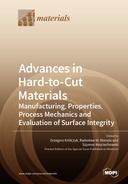Explore

Advances in Hard-to-Cut Materials
0 Ungluers have
Faved this Work
Login to Fave
The rapid growth of modern industry has resulted in a growing demand for construction materials with excellent operational properties. However, the improved features of these materials can significantly hinder their manufacture and, therefore, they can be defined as hard-to-cut. The main difficulties during the manufacturing/processing of hard-to-cut materials are attributed especially to their high hardness and abrasion resistance, high strength at room or elevated temperatures, increased thermal conductivity, as well as resistance to oxidation and corrosion. Nowadays, the group of hard-to-cut materials is extensive and still expanding, which is attributed to the development of a novel manufacturing techniques (e.g., additive technologies). Currently, the group of hard-to-cut materials mainly includes hardened and stainless steels, titanium, cobalt and nickel alloys, composites, ceramics, as well as the hard clads fabricated by additive techniques. This Special Issue, “Advances in Hard-to-Cut Materials: Manufacturing, Properties, Process Mechanics and Evaluation of Surface Integrity”, provides the collection of research papers regarding the various problems correlated with hard-to-cut materials. The analysis of these studies reveals the primary directions regarding the developments in manufacturing methods, characterization, and optimization of hard-to-cut materials.
This book is included in DOAB.
Why read this book? Have your say.
You must be logged in to comment.
Rights Information
Are you the author or publisher of this work? If so, you can claim it as yours by registering as an Unglue.it rights holder.Downloads
This work has been downloaded 364 times via unglue.it ebook links.
- 78 - pdf (CC BY-NC-ND) at Unglue.it.
Keywords
- abrasive machining
- additive manufacturing
- adhesion strength
- Alloy
- alloying
- aluminium matrix composite
- aluminum alloy 6061 T6
- artificial neural network
- Bioactivity
- burr
- chips
- corrosion resistance
- cutting temperature
- drilling
- dynamometer
- EDC
- elastic modulus
- environmentally friendly
- evolutionary algorithm
- forces
- fused deposition modelling
- hard turning
- hard–to–cut materials
- high speed milling (HSM)
- History of engineering & technology
- hole quality
- intelligent optimization
- investment casting
- Machining
- magnesium
- material swelling and springback
- mathematical modelling
- Mechanics
- micro-groove
- microcracks
- microhardness
- microhardness research
- modeling
- multiscale
- nano-cutting fluids
- nature inspired hybrid algorithm
- nickel-based alloys
- Nimonic-90
- optimization
- porosity research
- power consumption
- prediction
- resin bond
- roughness
- roundness
- sapphire substrate
- SLM technology
- spark plasma sintering
- surface
- surface finish
- surface integrity
- surface roughness
- Technology, engineering, agriculture
- Technology: general issues
- Texture
- Ti-6Al-4V
- titanium alloy
- tool wear
- turning
- ultrasonic elliptical vibration assisted cutting
- ultrasonically assisted turning
- wear
Links
DOI: 10.3390/books978-3-03928-355-2Editions


